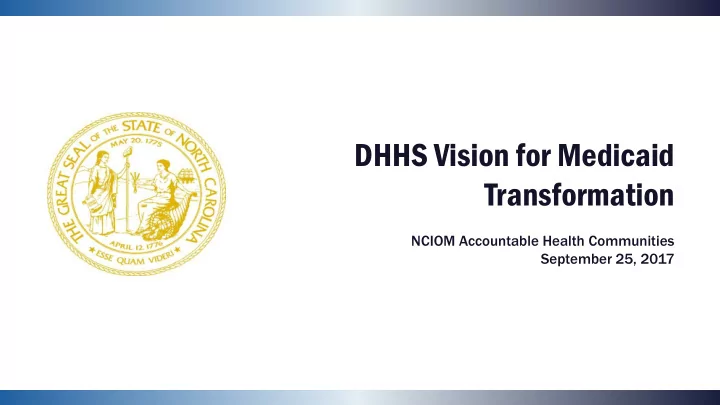

DHHS Vision for Medicaid Transformation NCIOM Accountable Health Communities September 25, 2017
Buying Health: Health & Social Services Expenditure by Country 50 45 EXPENDITURE AS % OF GDP 40 35 30 25 20 15 10 5 0 Bradley EH. BMJ Qual Saf 2011 Health Expenditures Social Service Expenditures
Buying Health Health Care Spending Drivers of Health Health Care 10% Other Environmental 10% Exposures Behavioral 5% Patterns 40% Social Circumstance Genetic 15% Predisposition Direct Medical 30% Schroeder SA. N Engl J Med 2007 Care 90% The single greatest opportunity to improve health lies in addressing a person’s unmet s t social al n need eds.
DHHS Vision for Addressing Social Determinants of Health We envision a North Carolina that optimizes health and well-being for all people by effectively stewarding resources that bridge our communities and our healthcare system.
Medicaid Proposed Program Design for Managed Care • Advances high-value care, improves population health, engages and supports providers, and establishes a sustainable program with predictable costs. • Improve the health through an innovative, whole-person centered and well- coordinated system of care, which addresses both medical and non-medical drivers of health.
Promoting Quality, Value, Population Health • Statewide quality strategy − Singe set of statewide quality measures and metrics to assess performance and drive progress • Integrate physical health, behavioral health, SUD, and I/DD services • Care management and provider support − Advanced Medical Homes • Value-based payment (VBP) − Focus care on population health, appropriateness of care, and other measures of value • Data collection and sharing capabilities • Address health-related social needs and reduce health inequities
Addressing Social Determinants as Part of Overall Health • Standardized screening for social needs − Develop standardized screening tool focused on unmet social needs (i.e. housing instability, transportation needs, food insecurity) • Resource Database − Up-to-date list of benefits/ community services and access points to services − Used to connect individuals with unmet social needs to resources • Resource Mapping − Real-time map of SDOH indicators at community and zip code level to display areas with highest disparity and need • Demonstration Projects − DHHS will scale, strengthen and sustain existing innovative initiatives that aim to more closely link healthcare and social services − Focused on evidence-based interventions − Evaluation and scaling
Opioid Epidemic
In 2016, over 1,200 200 North Carolinians DIED DIED from opioid overdose, an over 20% 20% increase se over 2015. In 2016, EMS reversed an opioid overdose using naloxone more than 13, 13,000 000 times.
With unprecedented availability of cheap he heroin in and and fent ntanyl yl… … MORE RE PEO PEOPLE E ARE ARE DYING . 700 350% increase in deaths since 1999 600 549 Commonly Prescribed Opioid Medications 500 Other Synthetic Narcotics Heroin deaths increase Heroin 400 364 800%+ since 2010 Cocaine 300 293 254 200 100 0 1999 2000 2001 2002 2003 2004 2005 2006 2007 2008 2009 2010 2011 2012 2013 2014 2015
The epidemic is devastating our famili ilies From 2004-2015, NC has seen 893% In the last 5 years, NC has seen 25% increase increase in hospitalizations associated with in children in foster care (10,500 children). drug withdrawal in newborns.
North Carolina Opioid Action Plan Focus Areas 1. Create a coordinated infrastructure 2. Reduce oversupply of prescription opioids 3. Reduce diversion of prescription drugs and flow of illicit drugs 4. Increase community awareness and prevention 5. Make naloxone widely available and link overdose survivors to care 6. Expand treatment and recovery oriented systems of care 7. Measure our impact and revise strategies based on results
Early Childhood Health & Education
North Carolina has an infant mortality rate of 7.2 Infant Mortality Rates 30 24.1 25 23.7 20.4 20 15 10 7.2 5.8 5 0 United States North Carolina Hyde County Bertie County Clay County
North Carolina has an infant mortality rate of 7.2 Infant Mortality Rate 30 25 24.1 23.7 21.8 20.4 20.3 20 15 10 7.2 6.9 6.7 5.8 5 0 United States Chile Russia North Algeria Hyde County Mongolia Bertie Clay County Carolina County
Give all North Carolina children a strong start • Expand access to health care for our kids. • One in every 11 children in North Carolina (9.4%) is uninsured • Improve birth outcomes in North Carolina. • Over half of all pregnancies are unintended • Invest in prenatal and perinatal care • Invest in high-quality child care that helps prepare children for school and life academically, socially, and emotionally • Smart Start, NC Pre-K, child care subsidies Strengthening families and keeping children in their homes • with their parents • NC has seen a 25% increase in children in foster care in the last 5 years • Social Services System Reform
Questions
Recommend
More recommend